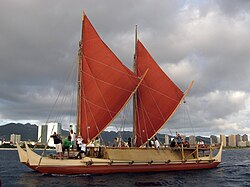

Jellore is a traditional Sumatran sailing craft. These boats are long and narrow, and fitted with double outriggers that stands out considerable distance from the sides. [1] Sometimes they only have one outrigger, which is alternately set in windward and leeward. [2] These boats are rigged with tanja rig. When the sail is partly furled, the ends of the two booms curve downwardly and inserted into the floats of the outrigger. [3]




